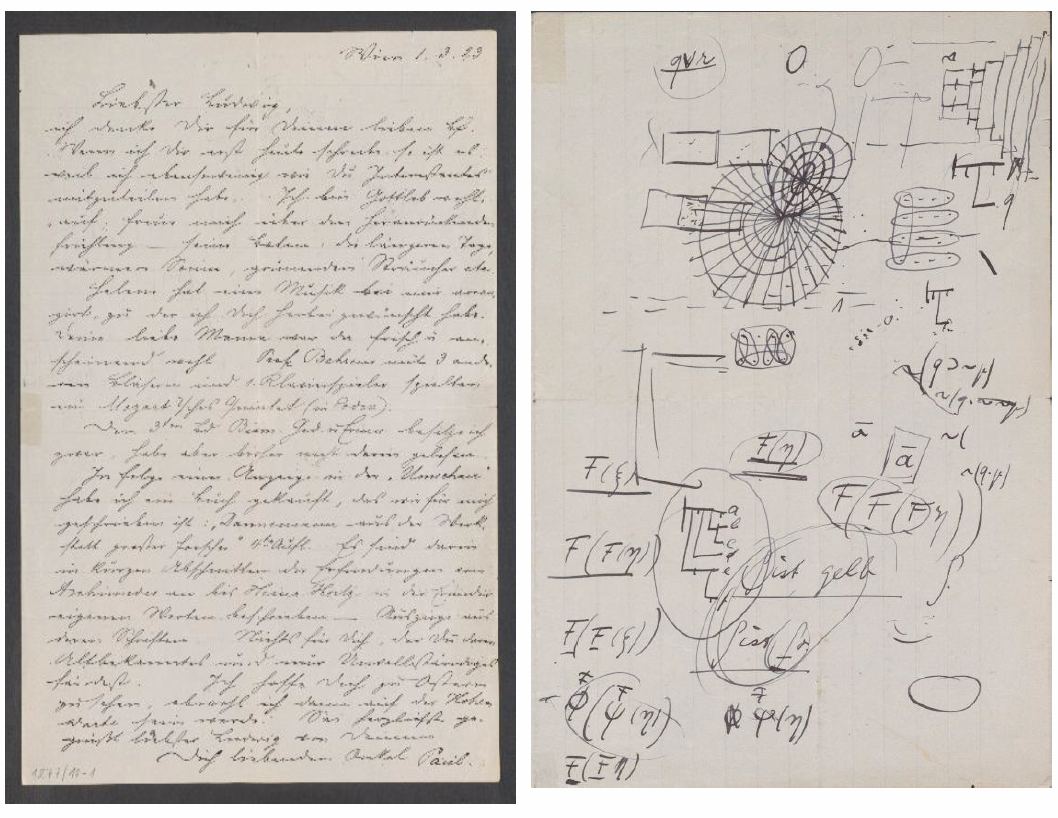FROM THE ARCHIVES
Abstract
Within the rather large Wittgenstein-collection at the Austrian National Library are 14 letters to Ludwig Wittgenstein from his uncle Paul (1848-1928), written between 1914 and 1923. The last of these letters, written on 1st March 1923, contains a little surprise. On the backside of this letter, the logical remarks and draft graphics which are recorded are obviously penned by the hand of Ludwig Wittgenstein.
Table of contents

Fig. 1: Letter from Uncle Paul Wittgenstein to Ludwig dated 1.3.1923 (Austrian National Library, Autograph 1277/10-1): frontside and backside. Published by kind permission of The Master and Fellows of Trinity College Cambridge.
Within the rather large Wittgenstein-collection at the Austrian National Library1 are 14 letters to Ludwig Wittgenstein from his uncle Paul (1848-1928)2, written between 1914 and 1923.3 (Wittgenstein finished his Logisch-philosophische Abhandlung at his uncle Paul’s house in Hallein July 1918.)4 The last of these letters, written on 1st March 1923, contains a little surprise.
On the backside of this letter, the logical remarks and draft graphics which are recorded are obviously penned by the hand of Ludwig Wittgenstein. It seems probable that he used the empty backside of his uncle’s letter for his notes some time not much later than the date of the letter. This is remarkable because we have no other written philosophical document of Wittgenstein’s from around that time, i.e. after he finished the corrections of the page proofs of the Tractatus in August 1922.
It might be of some interest that a few months later, in September 1923, Frank P. Ramsey visited Wittgenstein in Puchberg, intensively discussing the Tractatus with him.5 It is possible that the drafts on the backside of this letter derive from these discussions with Frank Ramsey, thus from autumn 1923.
At first sight, Wittgenstein’s notes look informal and unsystematic. Thus it seems probable that they were written casually during a discussion, maybe with Frank Ramsey. Formulas in Peano-Russell symbolism are clearly readable: q v r (upper left corner); (q כ ~p) / ~ (q.~~p) / ~(q.p) (middle right side). Also Frege notations are identifiable (upper right corner andcenter lower half), beside the sentence: “f ist gelb”.
From the recognizable logical formulas, it seems probable that this draft of Wittgenstein’s is related to the problem of the logical incompatibility of color sentences as it is formulated in Tractatus 6.3751 and appears first in his war diaries on 16.08.1917.6
In the Tractatus Wittgenstein clearly states that it is a logical necessity that a single point in our visual field cannot simultaneously have two different colors, or as he writes: “The assertion that a point in the visual field has two different colours at the same time, is a contradiction.” (Tractatus 6.3751, Ogden translation). But on the other hand, it is one of the essential postulations of the Tractatus that elementary propositions are logically independent: “It is clear that the logical product of two elementary propositions can neither be a tautology nor a contradiction.” (Tractatus 6.3751, Ogden translation)
As a consequence either sentences like “A is green” and “A is red” are not elementary propositions, or the claim for a strict logical independency of elementary propositions must be given up. Wittgenstein later started to think in both of these directions.
It is widely recognized that this problem of the incompatibility of color propositions was one of the central topics which led Wittgenstein to reconsider and revise his Tractatus conceptions of elementary propositions and language as a whole that subsequently initiated the transition into his later philosophy. As Josef Rothhaupt has pointed out, in this subsequent revision of his philosophical position Frank Ramsey’s critiques of the Tractatus played an important role (Rothhaupt 1996, p. 45ff). Immediately in MS 105, started in Cambridge in February 1929, the subject of the incompatibility of color propositions appears again (p. 70 ff) and alike in the article “Some Remarks on Logical Form” from summer 1929.
The dominating figure on this autograph, in the upper half of the paper, is puzzling and seems to be unique in Wittgenstein’s work. The two circles (or ovals) with concentric and radial lines are interfused in such a way that the center of the smaller one lies exactly on the border of the larger and vice versa. They can be recognized also as spatial figures like cones. The inner circles of the larger circle are not regular circles, but have a peaked nose toward the other smaller circle. It seems plausible that Wittgenstein wants to show two different colors interfusing each other – as he put it later in MS 106 (p. 71): “Der erste Gedanke ist, daß es unverträglich ist, daß zwei Farben an einem Ort zugleich sein sollten. Der nächste ist, daß zwei Farben an einem Ort sich nur zu einer resultierenden Farbe ergänzen. …”
References
- Nedo, M., 1983. Ludwig Wittgenstein. Sein Leben in Bildern und Texten. Frankfurt a. M.: Suhrkamp.
- Monk, R., 1990. Ludwig Wittgenstein. The Duty of Genius. London: Cape.
- Rothhaupt, J., 1996. Farbthemen in Wittgensteins Gesamtnachlaß. Weinheim: Beltz Athenäum.
- Wittgenstein, L., 2005. Ludwig Wittgenstein: Complete Correspondence. Electronic Edition, ed. Brenner Archiv, Innsbruck. Charlottesville: Intelex.
Biographical note
Alfred Schmidt studied philosophy at the University of Vienna and is now working at the Austrian National Library as scientific assistant to the director general. He is also responsible for the Wittgenstein collection at the Department of Manuscripts and Rare Books of the Austrian National Library. His publications treat Wittgenstein’s Nachlass as well as other topics.
Refbacks
- There are currently no refbacks.
